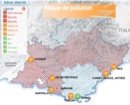ATMOPACA is the result of the merger of two organizations, one based in Nice and the other in Marseille, responsible for monitoring air quality in the region. These two entities merged in 2006 to create ATMOPACA. This organization is an association governed by the so-called “1901” law; it is independent but approved by the Ministry of Environment and Sustainable Development to carry out its various missions. ATMOPACA is not only present in the Southeast but there are about thirty similar organizations throughout France. It is an agency based on the principle of collegiality where scientists, regional authorities, the State, and industries required to pay taxes for their activities harming the environment and air quality all come together.
ATMOPACA has defined five main missions: to monitor and predict air quality, anticipate pollution peaks, provide daily information and in case of pollution episodes, understand pollution phenomena by establishing the link between air and health as well as between air and the environment, and finally contribute to discussions on land planning.
To better understand the situation and the phenomenon of pollution peaks, Nice Premium interviewed Yann Channac-Mongredien, a research engineer at ATMOPACA.
Nice Premium: Can you explain what your job entails?
Yann Channac-Mongredien: I organize air quality monitoring at a global level to comply with European and French regulations. I also develop the “indoor air” competence in public-access buildings. Additionally, I create maps for ATMOPACA’s publications, manage the website, and participate in the pollution on-call duty (Editor’s note: a plan for severe pollution events managed by the prefecture)… Like all ATMOPACA employees, I have very diverse tasks!
NP: What measures and techniques are used?
YCM: Once the measurement sites are selected, whether permanent or temporary, technical means are deployed to ensure the highest possible data quality. The work of validation and maintenance ensures reliable pollution measurements. We use weighing with a quartz microbalance. Suspended particles in the air sample deposit on a collection filter, which is placed on a quartz crystal vibrating at a frequency of 200 Hertz. The particle mass changes the quartz’s vibration frequency. This change is continuously measured and converted into mass variations.
NP: Can you describe the current atmospheric situation in Nice?
YCM: The air quality is poor in Nice at the moment. The sun, heat, and low winds promote the accumulation of pollution and ozone formation. Despite this, the wind remains strong enough to keep levels from rising too high: the recommendation threshold has not been exceeded.
NP: What can we expect in the coming days and weeks? How will the situation evolve in Nice?
YCM: It is impossible to foresee weeks in advance. For the upcoming days, the situation should improve with stronger winds.
NP: Can you compare this to last year’s situation at the same time?
YCM: The situation is very similar to last year, but these two years are atypical: last year, we experienced a summer with gloomy, disrupted weather. This year, we have the same for now.
NP: How do you explain such peaks in Nice?
YCM: Nice combines several unfavorable factors: intense automobile traffic, a dense urban area, terrain behind the city that limits pollutant dispersion, and summer sunlight that promotes photochemical pollution (ozone) formation. Not to mention air masses from Bouches-du-Rhône or Italy that can bring pollution from outside the department.
NP: Which areas are the most affected by pollution in Nice?
YCM: Ozone pollution affects very wide areas, so it is relatively homogeneous across the city. However, be aware: more ozone is measured on the outskirts of the city, but that does not mean there is less pollution in the city center. It only means that ozone pollution has not yet formed downtown and that the pollution takes a different form. Furthermore, we are talking about ozone here, but the most common pollution is nitrogen dioxide and suspended particles. These pollutions are present near traffic routes, in city centers, and near industrial areas. They are less talked about because there are fewer “peak” situations on which the public and media focus, but it is a chronic pollution, present every day. We must not forget the indoor pollution, often more significant than outdoors, especially in cases of insufficient ventilation.
NP: What are the risks associated with ozone pollution for the people of Nice?
YCM: Air pollution causes respiratory problems: irritation of the respiratory tract, shortness of breath, and a feeling of respiratory oppression. Long term, pollution can reduce respiratory capacity, exacerbate respiratory and cardiovascular problems, and in severe cases, facilitate the development of cancers.
NP: In your opinion, have the measures taken in recent days been effective?
YCM: These measures are effective but insufficient. To limit pollution, whether during peaks or every day, pollutant emissions must be reduced. And for that, we need to reduce transportation (by increasing public transport options and discouraging car use, shortening home-to-work and home-to-service trips), reduce energy consumption (heating, air conditioning, lighting) which causes direct or indirect pollution, reduce waste production…


